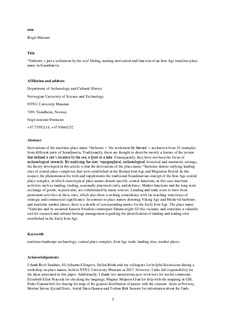*Sæheimr: Just a Settlement by the Sea? Dating, Naming Motivation and Function of an Iron Age Maritime Place Name in Scandinavia
Journal article, Peer reviewed
Accepted version

Åpne
Permanent lenke
http://hdl.handle.net/11250/2636089Utgivelsesdato
2019Metadata
Vis full innførselSamlinger
Sammendrag
Derivations of the maritime place name *Sæheimr—‘the settlement by the sea’—are known from 54 examples from different parts of Scandinavia. Traditionally, these are thought to describe merely a feature of the terrain that defined a site’s location by the sea, a fjord or a lake. Consequently, they have not been the focus of archaeological research. By analysing the sites’ topographical, archaeological-historical and onomastic settings, the theory developed in this article is that the derivations of the place name *Sæheimr denote outlying landing sites of central place complexes that were established in the Roman Iron Age and Migration Period. In this respect, the phenomenon fits with and supplements the traditional Scandinavian concept of the Iron Age central place complex, in which stereotypical place names denote specific central functions, in this case maritime activities such as landing, trading, seasonally practised crafts, and defence. Market functions and the long-term exchange of goods, in particular, are collaborated by many sources. Landing and trade seem to have been prominent activities at these sites, which also show a striking coincidence with far-reaching waterways of strategic and commercial significance. In contrast to place names denoting Viking Age and medieval harbours and maritime market places, there is a dearth of corresponding names for the early Iron Age. The place name *Sæheimr and its assumed eastern-Swedish counterpart Sätuna might fill this vacuum, and constitute a valuable tool for research and cultural heritage management regarding the identification of landing and trading sites established in the early Iron Age.